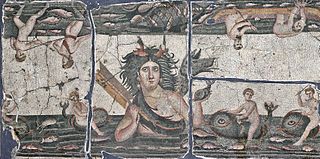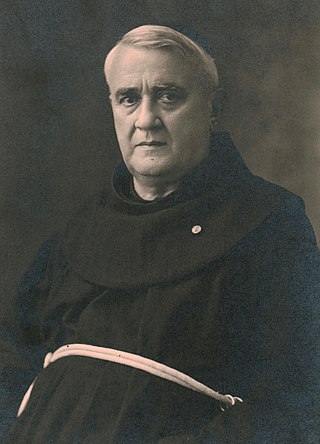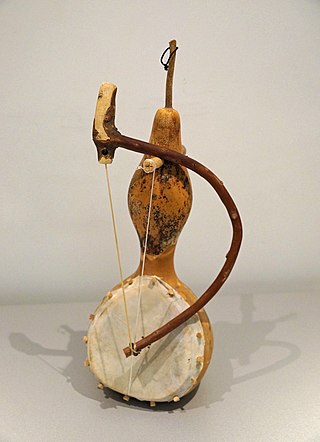Related Research Articles
E Bukura e Dheut is a character in Albanian mythology and folklore, depicted in some traditions as a crafty fairy, and in other traditions as a chthonic/earth goddess, the counterpart of e Bukura e Detit and i Bukuri i Qiellit. In some Albanian traditions she is regarded as the sister of e Bukura e Detit and the consort of Baba Tomor.

Prende is the dawn-goddess, goddess of love, beauty, fertility, and protector of women, in the Albanian pagan mythology. She is also called Afërdita in reference to Hylli i Dritës, Afêrdita "the Star of Light, Afêrdita" and to Ylli i Mbrëmjes, Afërdita. According to some Albanian traditions, Prende is the daughter of Zojz, the Albanian sky and lighning god.
Shurdh is a weather and storm god in Albanian pagan mythology, who causes hailstorms and throws thunder and lightning. Shurdh was worshiped in northern Albania until recent times.
Verbt or Verb is a fire and wind god in Albanian pagan mythology. By controlling the wind he is able to fan the flames of fire and move water, the opposite element to fire. Also known as Shën Verbti or Rmoria, he was worshiped in northern Albania until recent times.

Malësia e Madhe, known simply as Malësia, is a historical and ethnographic region in northern Albania and eastern central Montenegro corresponding to the highlands of the geographical subdivision of the Malësi e Madhe District in Albania and Tuzi Municipality in Montenegro. The largest settlement in the area is the town of Tuzi.

The kulshedra or kuçedra is a water, storm, fire and chthonic demon in Albanian mythology and folklore, usually described as a huge multi-headed female serpentine dragon. The kulshedra is believed to spit fire, cause drought, storms, flooding, earthquakes and other natural disasters against mankind. In Albanian mythology she is usually fought and defeated by a drangue, a semi-human winged divine hero and protector of mankind. Heavy thunderstorms are thought to be the result of their battles.

Thalassa was the general word for 'sea' and for its divine female personification in Greek mythology. The word may have been of Pre-Greek origin.

Mirdita is a region of northern Albania whose territory is synonymous with the historic Albanian tribe of the same name.

Gjergj Fishta was an Albanian Franciscan friar, poet, educator, politician, rilindas, translator and writer. He is regarded as one of the most influential Albanian writers of the 20th century due to his epic masterpiece Lahuta e Malcís and the editor of two of the most authoritative magazines after Albania's independence, Posta e Shypniës and Hylli i Dritës.

Albanian folk beliefs and mythological stories comprise the beliefs expressed in the customs, rituals, myths, legends and tales of the Albanian people. The elements of Albanian mythology are of ancient Paleo-Balkanic origin and almost all of them are pagan. Albanian folklore evolved over the centuries in a relatively isolated tribal culture and society. Albanian folk tales and legends have been orally transmitted down the generations and are still very much alive in the mountainous regions of Albania, Kosovo, western North Macedonia, lands formerly inhabited by Albanians like Montenegro and South Serbia and among the Arbëreshë in Italy and the Arvanites in Greece.
Zana is an Albanian mythological figure usually associated with mountains, springs and streams, forests, vegetation and animals, and sometimes destiny. Zana is thought to have been originally a pre-Roman deity, and an Illyrian goddess equivalent of the Ancient Greek Artemis and Roman Diana.
The drangùe is a semi-human winged divine figure in Albanian mythology and folklore, associated with weather and storms. Babies destined to become drangue are born with their heads covered in caul and with two or sometimes four wings under their arms. The drangue hold supernatural powers, especially in the wings and arms. He is made invulnerable by the singular conjunction produced at his birth, and can die only if this conjunction is repeated once again. The main goal of the drangue is to fight the kulshedra in legendary battles. He uses meteoric stones, lightning-swords, thunderbolts, piles of trees and rocks to defeat the kulshedra and to protect mankind from storms, fire, floods and other natural disasters caused by her destructive power. Heavy thunderstorms are thought to be the result of their battles. The drangue and their myth are extensively and accurately portrayed in the Albanian folk tale "The Boy who was Brother to the Drague".

The Kângë Kreshnikësh are the traditional songs of the heroic non-historical cycle of Albanian epic poetry. They are the product of Albanian culture and folklore orally transmitted down the generations by the Albanian rhapsodes (lahutarë) who perform them singing to the accompaniment of the lahutë. The Albanian traditional singing of epic verse from memory is one of the last survival of its kind in modern Europe. The poems of the cycle belong to the heroic genre, reflecting the legends that portray and glorify the heroic deeds of the warriors of indefinable old times. The epic poetry about past warriors is an Indo-European tradition shared with South Slavs, but also with other heroic cultures such as those of early Greece, classical India, early medieval England and medieval Germany.
*En or *Enji is a reconstructed name of the fire or thunder god in the Albanian pagan mythology, which has continued to be used in the Albanian language to refer to Thursday. The theonym Enete was used by Albanian scholar and language master Kostandin Kristoforidhi in 1879 as the Albanian translation of Greek Zeus / Δία.

The Albanian tribes form a historical mode of social organization (farefisní) in Albania and the southwestern Balkans characterized by a common culture, often common patrilineal kinship ties tracing back to one progenitor and shared social ties. The fis stands at the center of Albanian organization based on kinship relations, a concept which can be found among southern Albanians also with the term farë.

Shala is a historical tribe and region of northern Albania in the valley of the river Shalë, in the Dukagjin highlands. At the end of the 19th century the tribe was Catholic and had c. 3,000 members. Today, descendants are widespread in Kosovo and are concentrated in Shala e Bajgorës.
Zojz is a sky and lightning god in Albanian pagan mythology. Regarded as the chief god and the highest of all gods, Zojz had been worshiped in northern Albania until the early 20th century. The cult practiced by the Albanians on Mount Tomorr in central Albania is considered as a continuation of the ancient sky-god worship. In classical antiquity Zojz is considered to have been worshiped by Illyrians as the ancestors of the Albanians. Albanian Zojz is clearly the equivalent and cognate of Messapic Zis and Ancient Greek Zeus.
The Vitore is a household divine serpent in Albanian mythology and folklore, associated with human destiny, good fortune and the souls of the ancestors. In folk beliefs the household serpent is strongly related to the cult of the hearth (vatër) and it is especially considered the guardian of the family and the house.

The vatër is the domestic hearth in Albanian folklore. The fire of the domestic hearth, zjarri i vatrës, holds divine attributes in folk beliefs, being considered the sustainer of the continuity between the world of the living and that of the dead, and ensuring the continuity of the tribe (fis) from generation to generation.
E Bukura e Detit is a character in Albanian mythology and folklore, depicted in some traditions as a sea-fairy / nymph, and in other traditions as a sea goddess, the counterpart of e Bukura e Dheut and i Bukuri i Qiellit. In some Albanian traditions she is regarded as the sister of e Bukura e Dheut.
References
Notes
Citations
- ↑ Ajeti 1982 , p. 100; Poghirc 1987 , p. 179; Elsie 2001 , p. 249; Bane 2016 , p. 306.
- ↑ Lambertz 1922 , pp. 47, 146–148
- ↑ Ajeti 1982 , pp. 38, 100
- ↑ Beekes 2009 , p. 530
- ↑ Lambertz 1922, pp. 47, 146–148
- ↑ Gawrych 2006, p. 115
- ↑ Lambertz 1922 , pp. 47, 146–148
Bibliography
- Ajeti, Idriz (1982). Studije iz istorije albanskog jezika. Akademija nauka i umetnosti Kosova.
- Bane, Theresa (2016). Encyclopedia of Beasts and Monsters in Myth, Legend and Folklore. McFarland. ISBN 978-0-7864-9505-4.
- Beekes, Robert S. P. (2009). Beek, Lucien van (ed.). Etymological Dictionary of Greek. Brill. ISBN 978-90-04-32186-1.
- Elsie, Robert (2001). A Dictionary of Albanian Religion, Mythology and Folk Culture. London: Hurst & Company. ISBN 1-85065-570-7.
- Gawrych, George (2006). The Crescent and the Eagle: Ottoman rule, Islam and the Albanians, 1874–1913. London: IB Tauris. p. 36. ISBN 9781845112875.
- Lambertz, Maximilian (1922). Albanische Märchen (und andere Texte zur albanischen Volkskunde). Wien: A. Hölder.
- Poghirc, Cicerone (1987). "Albanian Religion". In Mircea Eliade (ed.). The Encyclopedia of Religion. Vol. 1. New York: MacMillan Publishing Co. pp. 178–180.